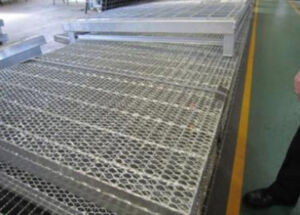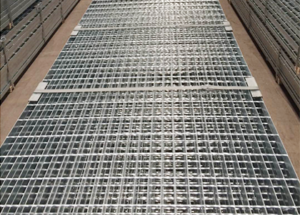اسٽيل جي گريٽ انهن جي بهترين سنکنرن جي مزاحمت لاء سڃاتو وڃي ٿو, انهن کي مختلف صنعتي ۽ تجارتي ايپليڪيشنن لاء مشهور انتخاب ڪرڻ. اسٽيل جي گردش جي منفرد ترتيب ۽ تعمير کي سخت ماحول ۾ سنسڪرن ۾ سنسڪرون ٺاهڻ ۾ مدد ڪندو آهي. هن آرٽيڪل ۾, اسان فيڪٽرن کي ڳوليندا سين جيڪي اسٽيل جي گريٽنگ جي مزاحمتي مزاحمتي مزاحمتي ۽ مختلف قسم جا سنسڪرائيزيشن تحفظ جا طريقا انهن جي پيداوار ۾ استعمال ڪيا ويا آهن.
اسٽيل گراسنگ جي مزاحمت جي مزاحمت جي هڪ اهم سببن مان هڪ آهي جيڪو انهن جي تعمير ۾ استعمال ٿيندو آهي. خاص طور تي, ڪاربان اسٽيل مان اسٽيل جي گريٽ ٺاهيا ويا آهن, بي داغ لوه, يا ايلومينيم. انهن مواد ۾, اسٽينلیس سٹیل ان جي غير معمولي مزاحمت لاء بيهي رهي آهي, ان کي ايپليڪيشنن لاء هڪ مثالي انتخاب ٺاهيو جتي نمي جي نمائش, ڪيميساٽ, ۽ ٻيا معزز عنصر هڪ خدشا آهن.


مواد جي ترتيب سان گڏ, اسٽيل جي انگن اکرن جي ڊزائن ۽ تعميرات پڻ انهن جي سنکنرن جي مزاحمت ۾ پڻ اهم ڪردار ادا ڪيو. اسٽيل گرڊ جو اوپن گرڊ جو نمونو پاڻي جي موثر نيڪال جي اجازت ڏئي ٿو, نمي جي جمع کي روڪڻ جيڪا سورن کي وٺي سگهي ٿي. وڌيڪ, اسٽيل جي گيٽنگ يا اسٽيلنگ جي ڪوٽنگ کي سنکنرن جي خلاف تحفظ جي اضافي پرت فراهم ڪندو آهي, انهن جي حياتي ۽ چيلينج ماحول ۾ استحڪام وڌائي ٿو.
جڏهن اهو اسٽيل جي گرجنگ جي مزاحمت جو جائزو وٺڻ لاء ايندو آهي, اهو مخصوص ماحولياتي حالتن تي غور ڪرڻ ضروري آهي ته انهن کي ظاهر ڪيو ويندو. عنصر جهڙوڪ نمي, گرمي پد جي وهڪري, ڪيميائي جي نمائش, ۽ لوڻ وارو پاڻي اسٽيل جي انگورن جي مزاحمت جي مزاحمت تي اثر انداز ٿي سگهي ٿو. انهن ماحولياتي عنصر کي سمجهڻ سان, انجنيئر ۽ ڊزائنر انهن جي ايپليڪيشنن لاء اسٽيل جي گرجنگ جو سڀ کان مناسب قسم چونڊيندو آهي.
اسٽيل گراسٽ ۾ سنکنرن جي تفريح جي مزاحمت جي هڪ ٻيو نازڪ پهلو ۽ سنڀال جي مشق آهي. باقاعدي معائنو, صاف ڀيڻ, ۽ حفاظتي ڪوٽنگس سنکنرن جي اثرن جي اثرن کي گهٽائڻ ۽ اسٽيل جي انگورن جي حياتيء کي گهٽائڻ ۾ مدد ڪري سگھن ٿا. اضافي طور تي, اسٽيل جي نمائش جي مناسب قسم جي معزز جي نمائش جي بنياد تي معمول جي نمائش جي بنياد تي ڊگهي عرصي تائين ڪارڪردگي ۽ حفاظت کي يقيني بڻائڻ لاء ضروري آهي.
خلا ۾, اسٽيل جي گريٽز واقعي سنکنرن مزاحمتي آهن, انهن جي مادي ترتيب جي مهرباني, نمونو, تعميراري, ۽ حفاظتي ڪوٽنگ. انهن عنصر کي سمجهڻ سان جيڪي انهن جي سنکنرن جي مزاحمت ۾ حصو وٺن ٿا, انڊسٽريز ۽ ڪاروبار کي باخبر فيصلا ڪري سگھن ٿا جڏهن اسٽيل جي انگورن کي انهن جي مخصوص ايپليڪيشنن لاء چونڊي چونڊيندا آهن, چئلينج ماحول ۾ بهتر ڪارڪردگي ۽ استحڪام کي يقيني بڻائڻ.

